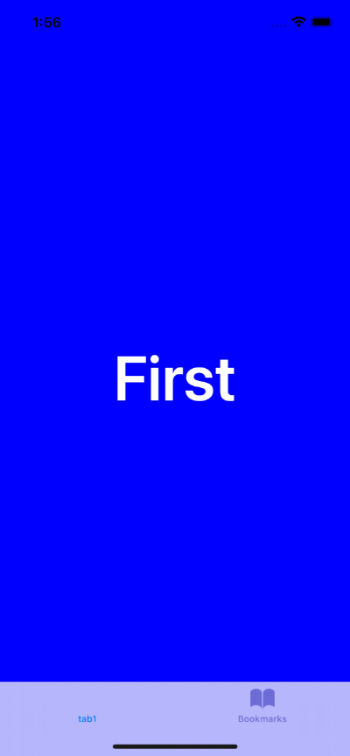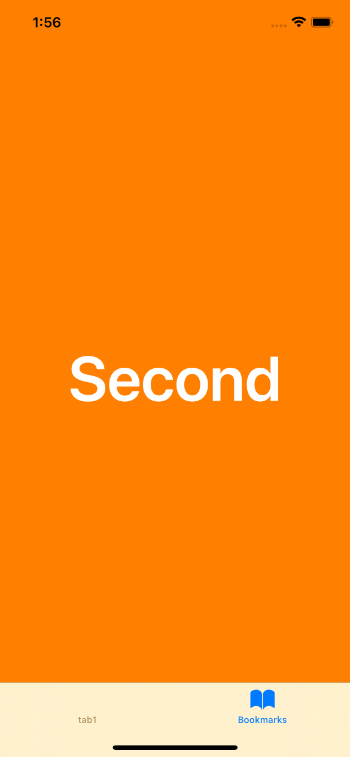はじめに
UITabBarControllerをコードベースで作成したかったのですが、既存の記事だとクラッシュしまくってしまったので、
コードベースで作成する方法を書きます。
実装方法
まずは、TabBarに表示するに画面を作成します。
切り替えをわかりやすくするためのものなので、適当で大丈夫です。
ここではFirstViewControllerとSecondViewControllerとしておきます。
import UIKit
final class FirstViewController: UIViewController {
let centerLabel: UILabel = {
let label = UILabel()
label.text = "First"
label.font = UIFont.boldSystemFont(ofSize: 70.0)
label.textColor = UIColor.white
return label
}()
override func loadView() {
view = UIView()
view.backgroundColor = .blue
centerLabel.translatesAutoresizingMaskIntoConstraints = false
view.addSubview(centerLabel)
NSLayoutConstraint.activate([
centerLabel.centerYAnchor.constraint(equalTo: view.centerYAnchor),
centerLabel.centerXAnchor.constraint(equalTo: view.centerXAnchor)
])
}
}
import UIKit
final class SecondViewController: UIViewController {
let centerLabel: UILabel = {
let label = UILabel()
label.text = "Second"
label.font = UIFont.boldSystemFont(ofSize: 70.0)
label.textColor = UIColor.white
return label
}()
override func loadView() {
view = UIView()
view.backgroundColor = .orange
centerLabel.translatesAutoresizingMaskIntoConstraints = false
view.addSubview(centerLabel)
NSLayoutConstraint.activate([
centerLabel.centerYAnchor.constraint(equalTo: view.centerYAnchor),
centerLabel.centerXAnchor.constraint(equalTo: view.centerXAnchor)
])
}
}
次にUITabBarControllerを継承したMainTabBarControllerを作成します。
import UIKit
final class MainTabBarController: UITabBarController {
override func viewDidLoad() {
super.viewDidLoad()
setupTab()
}
func setupTab() {
let firstViewController = FirstViewController()
firstViewController.tabBarItem = UITabBarItem(title: "tab1", image: .none, tag: 0)
let secondViewController = SecondViewController()
secondViewController.tabBarItem = UITabBarItem(tabBarSystemItem: .bookmarks, tag: 0)
viewControllers = [firstViewController, secondViewController]
}
}
以下のようにTabの見た目を変更することができます。
firstViewController.tabBarItem = UITabBarItem(title: "tab1", image: .none, tag: 0)
secondViewController.tabBarItem = UITabBarItem(tabBarSystemItem: .bookmarks, tag: 0)
最後にviewControllersの配列の中に作成したTabをそれぞれ追加します。
viewControllers = [firstViewController, secondViewController]
これでTabBarControllerと、表示させるViewControllerができました。
最後に作成したTabBarControllerを最初に表示させるためにSceneDelegateを書き換えます。
SceneDelegateとはなんぞやという方は以下のいい感じの記事をご覧ください
iOS13のSceneDelegate周りのアプリの起動シーケンス
iOS13から導入されるSceneDelegateとは
func scene(_ scene: UIScene, willConnectTo session: UISceneSession, options
connectionOptions: UIScene.ConnectionOptions) {
// Use this method to optionally configure and attach the UIWindow `window` to the provided UIWindowScene `scene`.
// If using a storyboard, the `window` property will automatically be initialized and attached to the scene.
// This delegate does not imply the connecting scene or session are new (see `application:configurationForConnectingSceneSession` instead).
guard let _ = (scene as? UIWindowScene) else { return }
}
guard letのしたに以下のコードを追加し、MainTabBarControllerが最初に表示されるように書き換えます。
guard let _ = (scene as? UIWindowScene) else { return }
let window = UIWindow(windowScene: scene as! UIWindowScene)
self.window = window
let vc = MainTabBarController()
window.rootViewController = vc

